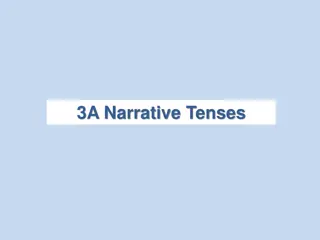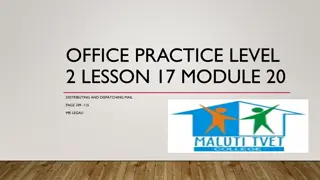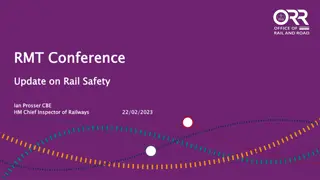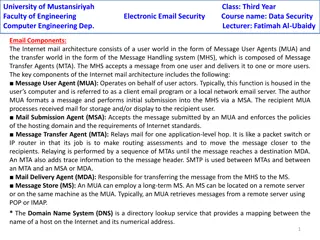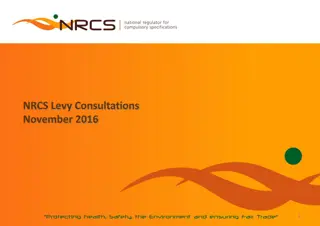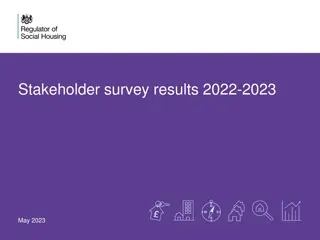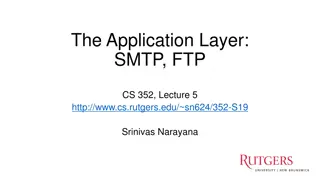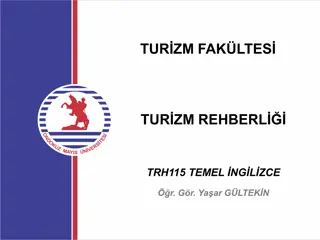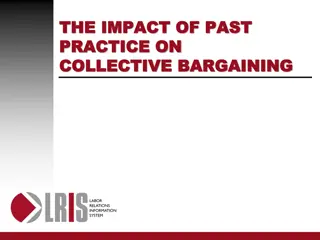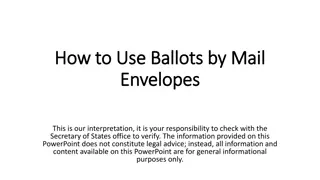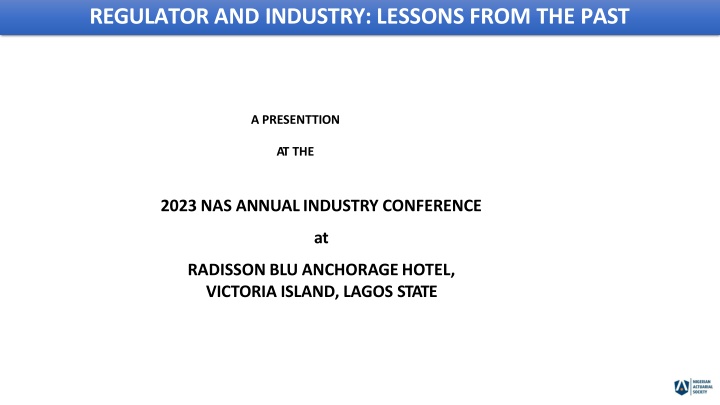
Insurance Regulation and Industry Oversight Insight
Delve into the vital aspects of insurance regulation and industry supervision, exploring the roles and responsibilities of regulators and operators. Gain insights from past lessons to shape future practices and ensure a robust insurance sector. The presentation emphasizes the necessity of effective resolution regimes and preconditions for optimal functioning, highlighting the significance of independence and adherence to regulatory frameworks.
Download Presentation

Please find below an Image/Link to download the presentation.
The content on the website is provided AS IS for your information and personal use only. It may not be sold, licensed, or shared on other websites without obtaining consent from the author. If you encounter any issues during the download, it is possible that the publisher has removed the file from their server.
You are allowed to download the files provided on this website for personal or commercial use, subject to the condition that they are used lawfully. All files are the property of their respective owners.
The content on the website is provided AS IS for your information and personal use only. It may not be sold, licensed, or shared on other websites without obtaining consent from the author.
E N D
Presentation Transcript
REGULATOR AND INDUSTRY: LESSONS FROM THE PAST A PRESENTTION AT THE 2023 NAS ANNUALINDUSTRY CONFERENCE at RADISSON BLU ANCHORAGEHOTEL, VICTORIA ISLAND, LAGOS STATE
Outline 1.Introduction 2.Responsibilitiesof the insurance Regulator 3.Responsibilitiesof the insuranceOperators 4.Lessons fromthe Past 5.Conclusion
1. Introduction Key Concepts An imposition of rules by government, be it by the legislative or executive branch that are intended to specifically modify the economic behaviour of individuals and firms in the private sector and are often enforced by the use of penalties. Regulation An imposition of rules by government, be it by the legislative or executive branch or other agency,that apply to insurance activities. Insurance regulation Any authority that initiates and develops legislation to address the objective of insurance regulation. It may also be the supervisor. Any authority that carries out insurance supervision, which includes licencing, monitoring, issuing administrative and enforcement action to ensure compliance with legislation and regulation. when the insurance supervisor monitors (re)insurer and intermediary behaviour, and implements insurance rules through on-site and off-site supervision to verify compliance with the requirements for engaging in financial activities and using administrative measures and enforcement actions based on relevant legislation and regulation. Insurance regulator Insurance supervisor Insurance supervision Consists of all the people and activities involved in providing insurance services. Regulators, underwriters, reinsurers, brokers, agents, loss adjusters. Insurance industry Being free to take regulatory and supervisory action devoid of conflict of interest, without being subject to undue or inappropriate influence from stakeholders. Independence Page 3
1. Introduction Overview of IAIS Framework for Insurance Supervision Supervisory assessment Supervisory assessment and intervention LEVEL3 Common Solvency Structure and Standards Regulatory requirements LEVEL2 Market conduct Governance Financial the insurance supervisory authority Basic conditions for the effective functioning of Preconditions LEVEL1 the insurance sector and insurance supervision IAIS FrameworkforPrudentialRegulation
1. Introduction Pre-conditions for effective resolution regimes A well-established framework for financial stability,surveillance and policy formulation; An effective system of supervision, regulation and oversight of insurers; An effective mechanisms for the protection of policyholders; a well developed and effective financial marketinfrastructure; A robust accounting, auditing and disclosure regime;and A well-developed legal framework and judicial system, in particular liquidation/bankruptcyregime. These conditions are to a large extent outside the direct control or influence of an insurance supervisor or insurer; and affects the effectiveness of the Regulator and Operators.
1. Introduction The concept of insurance supervision entails the monitoring of insurance companies and intermediaries behaviour , insurance rules and regulations as well as taking enforcement actions against identified violations. including their compliance with Role of supervisory authority is to promote safe, stable, efficient, fair insurance markets, and economic development. Objective(s) need to be defined often, for the protection and benefit of policyholders Supervisory agencies may have somewhat different objectives: Canada: To safeguard depositors and policyholders from loss UK: To promote the safety and soundness of regulated firms WestAfrica: The protection of policyholders
2. Responsibilities of the Insurance Regulator Insurance regulatory responsibilities are divided into two primary categories: 1) Prudential (Financial) regulation seeks to protect policyholders against the risk that insurers will not be able to meet their financial obligations The oversight of individual supervised entities observance of capital and technical provisions to ensure their financial safety and soundness. 2) Marketconduct regulation attempts to ensure fair and reasonable insurance prices, products and trade practices. Both regulations are inextricably related and must be coordinated to achieve their specific objectives. Regulation of rates and market practices affects insurers financial performance; financial regulation constrains the prices and products insurers can reasonably offer. Both prudential and market conduct supervision are carried out simultaneously in most jurisdictions.
2. Responsibilities of the Insurance Regulator FinancialRegulatory Functions Protecting policyholders and the general public against excessive insurer insolvency risk is the primary goal of insurance regulation. Regulators protect policyholders interests by requiring insurers to meet certain financial standards and take corrective action when necessary. These statutes require insurers to meet certain minimum capital and surplus standards and financial reporting requirements and authorize regulators to examine insurers and take other actions to protect policyholders interests. A. Solvency regulation polices - affect a number of aspects of insurers operations, including requirements for: 1) Capitalization - Fixed Minimum Capital and Surplus Requirements; or use of Risk-Based Capital; 2) pricingand products; 3) reinsurance; 4) reserves; 5) investments restrictions; 6) asset-liability matching; 7) transactions with affiliates; and 8) Managementand Other financial requirements
2. Responsibilities of the Insurance Regulator FinancialRegulatory Functions (cont d) B. Solvency Monitoring - Solvency monitoring encompasses a broad range of regulatory activities, including 1. financialreporting 2. financial analysis and early-warningsystems 3. Examinations; and 4. other information as necessary toassess (re)insurer s financial condition. C. Intervention - Intervention and Receivership The nature of the appropriate regulatory action for a troubled insurer varies depending on the circumstances, but the essential objective is to prevent or minimize losses and to provide protection for policyholders.
3. Responsibilities of the Insurance Operators FunctionsPerformed by Insurersand Intermediaries 1) ProductDesign 2) Pricing 3) Productionand Distribution 4) Underwriting 5) LossSettlement 6) Investment 7) Reinsurance
3. Responsibilities of the Insurance Operators Claims Settlemen t Capital, Asset Mgt. & Compliance Underwriting and Reinsurance R&D/Product Development Pricing and Distribution
4. Lessons from the Past Tickingthe Boxes 1) Reserve requirements, and solvencymonitoring very good 2) Use of Technology to by the regulator and industry significantimprovement 3) Relationshipbetween the regulator and the industry- mutual 4) The regulatorand industryself-regulatorybodies very cordial 5) Regulator and industrycollaboration and cooperation on innovations very good 6) Effective supervision capacity of the regulator industry needs financial resources to fund identified gaps and improvement 7) Localcontent emphasis in the industry Significantimprovementhas been recorded 8) compliance of industry players with ethical standards of the industry - Unethical practice is the bane of the industryparticularly in Africa. Some few bad eggs exists in nearly all markets. 9) Quality of supervisory returns and other information - needs improvement 10) Capitalisation moderate,not yetrisk-based,requiresimprovement,affectedby severalfactors
4. Lessons from the Past SignificantTrends and Implications 1. The insurance industry s increasing complexity, risk and geographic scope place additional demands on regulators and industryalike. 2. The greater complexity of insurance products and investment strategies increases the opportunity for mismanagement, excessive risk-taking and fraud that can lead to costly insolvencies. 3. Industry growth, consolidation and financial risk - a wide variety of insurance products and services have appeared on the market to respondto a rapidly growing and diverse economy. 4. Industry consolidation is driven by a number of factors, including 1) the need to reduce expenses to improve profit margins; 2) the need to divest low-return, non-corebusinesses; 3) capitalneeds; 4) excess capacity; 5) increased liquidity to fund mergers and acquisitions; 6) globalizationof insurancemarkets; and 7) management strategies aimed at improving returns for owners.
4. Lessons from the Past SignificantTrends and Implications(cont d) A. The emergence of fewer, larger insurers presents advantages and disadvantages for regulation. Toobig to fail syndrome may set in. B. Integrationof financial services markets C. Globalization of markets D. Improving regulatory efficiency has been embarked upon by insurance regulators E. Information technology (IT) and electroniccommerce F. Demographic trends and public opinion G. The general aging of the population, combined with the shift of greater choice and risk to individuals and households H. Consumers difficulty in evaluating the risk-and-return characteristics of different insurance products and their vulnerability to abusive sales practices have increased their demand for regulatory protections.
5. Conclusion 1. Insurance regulators and industry should embrace change even as solvency considerations are foremost in financial regulators minds, and resulting in more disclosure or restrictions. 2. The insurance industry s increasing complexity, risk and geographic scope place additional demands on regulators and the industry alike. 3. Regulators must allow insurance markets to operate relatively freely to meet consumers needs but prevent abuses and correct market failures. 4. The greater complexity of products and investment strategies increases the opportunity for mismanagement, excessive risk-taking and fraud that can lead to costly insolvencies. 5. All of these developments have required regulators to become more sophisticated in policing insurers financial structure and activities to continue to achieve established public policy goals for safety and consumer protection. 6. Mutual suspicion by both parties exists but issues should be resolved through discussion and understanding.
THANK OU BARINEKA THOMPSON, FCA, CAMS-AUDIT. CEO, Mettlehouse Consulting Limited Contact:+234 803 322 3553, tbarineka@yahoo.com September21, 2023





